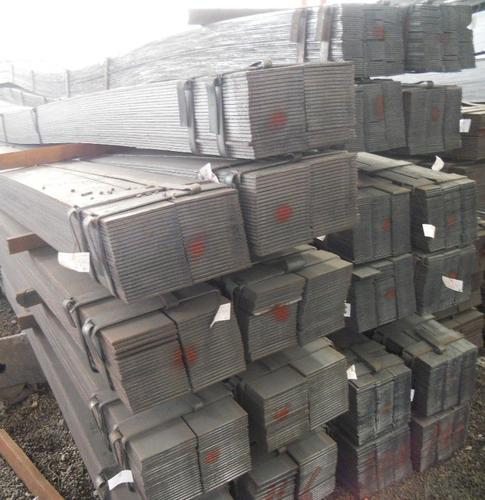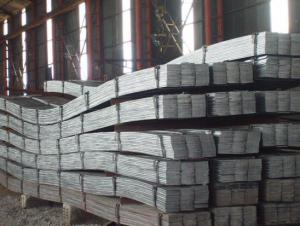High Quality Mild Steel Flat Bar with Grade Q235
- Loading Port:
- Tianjin
- Payment Terms:
- TT OR LC
- Min Order Qty:
- 25 m.t.
- Supply Capability:
- 100000 m.t./month
OKorder Service Pledge
OKorder Financial Service
You Might Also Like
Specification of Steel Flat Bar
Commodity: Carbon Steel Flat Bar
Standard: GB,JIS,ASTM,
Material: Q235,SS400 or Equivalent
Brand name: FLATSPACE
Origin place: China
Thickness: 3mm-30mm
Width:20mm-200mm
Length: Max 12m
Certification: SGS/BV
Chemical composition of Q235
Alloy No | Grade | Element(%) | ||||
C
| Mn
| S
| P
| Si
| ||
Q235
|
B
|
0.12—0.20 |
0.3—0.7 |
≤0.045 |
≤0.045
|
≤0.3
|
Physical properties of Q235
Alloy No | Grade | Yielding strength point(Mpa) | Tensile strength (Mpa) | Elongation after fracture(%) | ||||||
Thickness (mm) | Thickness (mm) | |||||||||
≤16 | >16--40 | >40--60 | >60--100 | ≤16 | >16--40 | >40--60 | >60--100 | |||
≥ | ≥ | |||||||||
Q235 |
B |
235 |
225 |
215 |
205 |
375--500 |
26 |
25 |
24 |
23 |
Above sheets show the technical data of Q235,we can also provide other materials similar to Q235.
Usage/Applications of Steel Flat Bar
Widely used for construction;
Machinery manufacturing;
Iron tower steel structure;
Shipbuilding; Steel grating;
Staircase;
Bridge;
Viaduct;
Railway spare parts;
Boilers making etc.
Packaging & Delivery of Steel Flat Bar
Packaging Details: The Steel Flat Bars are packed in bundles and loaded in 20 feet/40 feet container, or shipped by bulk cargo ,also we can do as customer's requirements.
Delivery Details:30~45 days upon the receipt of buyer payment by T.T. or L/C.
- Q: How do steel flat bars contribute to the overall stability of a structure?
- Steel flat bars contribute to the overall stability of a structure in several ways. Firstly, these bars are known for their high tensile strength, which means they can resist large amounts of force without easily bending or breaking. This strength allows them to provide structural support and prevent the structure from collapsing under heavy loads or external pressures. Additionally, steel flat bars are often used as braces or reinforcements in construction. They can be strategically placed and welded to different parts of the structure to increase its rigidity and prevent any potential deformations. By distributing the load more evenly, these bars help in maintaining the structural integrity and preventing any unwanted movements or vibrations. Moreover, steel flat bars are highly durable and resistant to corrosion, making them suitable for long-term use in various environments. This durability ensures that the structure remains stable and safe over time, even in harsh conditions or exposure to moisture or chemicals. Furthermore, the versatility of steel flat bars allows them to be used in a wide range of structural applications. Whether it's for beams, columns, trusses, or even as a base for other components, these bars provide stability and support to different parts of the structure. They can be easily customized and fabricated to meet specific design requirements, ensuring that the structure is built to withstand the intended loads and forces. In conclusion, steel flat bars play a crucial role in enhancing the overall stability of a structure. Their high tensile strength, ability to resist deformation, durability, and versatility make them indispensable components in construction projects. By providing support, reinforcement, and resistance to external forces, these bars contribute significantly to the structural integrity and safety of the overall built environment.
- Q: Are steel flat bars suitable for load-bearing structures?
- Yes, steel flat bars are suitable for load-bearing structures. Steel is known for its high strength and durability, making it an ideal material for constructing load-bearing structures. Steel flat bars, in particular, are commonly used in construction projects as they provide excellent support and stability. They are designed to withstand heavy loads and distribute weight evenly, making them reliable for load-bearing applications. Additionally, steel flat bars are versatile and can be easily fabricated and customized to meet the specific requirements of a structure. Overall, steel flat bars are a popular choice for load-bearing structures due to their strength, durability, and adaptability.
- Q: How do you prevent warping or distortion of steel flat bars during heat treatment?
- To prevent warping or distortion of steel flat bars during heat treatment, there are several key measures that can be taken. 1. Proper selection of steel grade: It is crucial to choose a steel grade that is less prone to warping or distortion during heat treatment. Some steel grades have better dimensional stability, such as low alloy steels, which can help minimize these effects. 2. Uniform heating and cooling: Ensuring a uniform and controlled heating and cooling process is essential. This can be achieved through the use of proper heating equipment, such as industrial furnaces with well-distributed heat sources. It is important to avoid localized heating or cooling, as this can lead to uneven expansion or contraction, causing warping or distortion. 3. Preheating: Preheating the steel flat bars before heat treatment can help alleviate internal stresses and reduce the risk of warping. This can be done by gradually increasing the temperature to the desired level in a controlled manner. 4. Proper fixturing: The use of appropriate fixtures or jigs during heat treatment can help support the steel flat bars and minimize distortion. Fixtures should be designed to evenly distribute the load and prevent bending or twisting during the heating and cooling process. 5. Slow cooling: Rapid cooling can induce internal stresses, leading to warping or distortion. Therefore, it is recommended to cool the steel flat bars slowly after heat treatment. This can be achieved by placing them in an insulated container or furnace, or by using heat sinks to control the cooling rate. 6. Stress-relieving treatment: After heat treatment, a stress-relieving treatment can be applied to further reduce internal stresses. This involves heating the steel flat bars to a specific temperature and holding it for a certain period of time, followed by a controlled cooling process. Stress-relieving can help restore dimensional stability and minimize warping or distortion. By following these preventive measures, it is possible to minimize the warping or distortion of steel flat bars during heat treatment, ensuring that the desired properties are achieved while maintaining dimensional integrity.
- Q: Are steel flat bars available in different colors?
- No, steel flat bars are not available in different colors. Steel is typically produced in its natural grey color, which is the result of its composition and production process. However, it is possible to apply different coatings or paint to steel flat bars to change their color. These coatings can provide additional protection against corrosion or simply serve aesthetic purposes.
- Q: Are steel flat bars suitable for making defense industry equipment or vehicles?
- Steel flat bars are indeed suitable for the production of defense industry equipment and vehicles. With its exceptional durability and strength, steel proves to be an optimal material for applications demanding resistance against impact, wear, and extreme conditions. The flat configuration of steel bars facilitates effortless fabrication and assembly into diverse components and structures, thereby rendering it versatile for defense industry equipment and vehicles. Moreover, steel is easily obtainable and cost-effective, guaranteeing efficient manufacturing and upkeep of defense equipment. Furthermore, steel can be readily tailored and adjusted to meet precise specifications, including ballistic protection or structural integrity, thereby further augmenting its appropriateness for defense industry applications.
- Q: How do you prevent burrs or sharp edges on steel flat bars during cutting?
- One way to prevent burrs or sharp edges on steel flat bars during cutting is to use a high-quality cutting tool or blade with sharp edges. Additionally, using a slower cutting speed and applying consistent pressure can help minimize the formation of burrs. Another effective method is to use cutting lubricants or coolant, which can reduce friction and heat during the cutting process, resulting in smoother edges. Regular maintenance and periodic sharpening of cutting tools are also crucial in preventing burrs and maintaining clean cuts.
- Q: How do steel flat bars contribute to the overall efficiency of industrial structures?
- Steel flat bars contribute to the overall efficiency of industrial structures by providing strength, stability, and versatility in construction. These bars are commonly used as structural components, such as beams, columns, and braces, due to their high tensile strength and ability to withstand heavy loads. Their flat shape allows for easy fabrication and welding, making them a cost-effective choice for constructing various industrial structures. Additionally, steel flat bars offer excellent durability, corrosion resistance, and long-term performance, ensuring the longevity and reliability of the overall structure.
- Q: What are the different coatings available for steel flat bars?
- Steel flat bars have various coating options available depending on the desired properties and specific application. Some commonly used coatings include: 1. Hot-dip galvanizing: The steel flat bar is immersed in molten zinc, creating a protective layer that offers excellent corrosion resistance and can withstand harsh environments. 2. Powder coating: A dry powder is applied to the steel flat bar and then heated to create a durable, chip-resistant protective layer. Powder coating comes in a wide range of colors. 3. Epoxy coating: Industrial settings often use epoxy coatings for corrosion protection. These coatings are applied as a two-part system and offer excellent chemical resistance and durability. 4. Paint: Steel flat bars can be painted with different types of paints, such as oil-based, acrylic, or epoxy paints. Paint coatings provide some level of corrosion protection and can be customized with various colors and finishes. 5. Vinyl coating: Vinyl coatings are commonly used for aesthetic purposes or to create a soft, non-slip surface. These coatings are applied by heat shrinking a vinyl sleeve onto the steel flat bar. When selecting the appropriate coating for steel flat bars, it is important to consider specific requirements, such as corrosion resistance, environmental factors, and aesthetic preferences. Consulting with a professional or coating manufacturer can help determine the best coating option for a particular project.
- Q: What are the common defects found in steel flat bars?
- Common defects found in steel flat bars include surface imperfections such as dents, scratches, or rust, as well as dimensional deviations like warping, bowing, or uneven thickness. Other defects can include cracks, laminations, or inclusions, which may affect the structural integrity of the bar.
- Q: What are the common tolerances for steel flat bars?
- The common tolerances for steel flat bars can vary depending on the specific requirements and standards set by the industry or customer. However, there are generally accepted tolerances that are widely used in the manufacturing and construction sectors. In terms of thickness, the common tolerance for steel flat bars is typically ± 0.005 inches or ± 0.13 millimeters. This means that the actual thickness of the flat bar can deviate by up to 0.005 inches or 0.13 millimeters from the specified thickness. For width, the common tolerance is usually ± 0.020 inches or ± 0.5 millimeters. This means that the actual width of the flat bar can vary by up to 0.020 inches or 0.5 millimeters from the specified width. In terms of length, the common tolerance is typically ± 0.125 inches or ± 3 millimeters. This means that the actual length of the flat bar can deviate by up to 0.125 inches or 3 millimeters from the specified length. It is important to note that these common tolerances may vary depending on the specific application, industry standards, or customer requirements. Therefore, it is always advisable to consult the relevant standards or specifications to determine the precise tolerances for a particular steel flat bar.
Send your message to us
High Quality Mild Steel Flat Bar with Grade Q235
- Loading Port:
- Tianjin
- Payment Terms:
- TT OR LC
- Min Order Qty:
- 25 m.t.
- Supply Capability:
- 100000 m.t./month
OKorder Service Pledge
OKorder Financial Service
Similar products
Hot products
Hot Searches
Related keywords



























